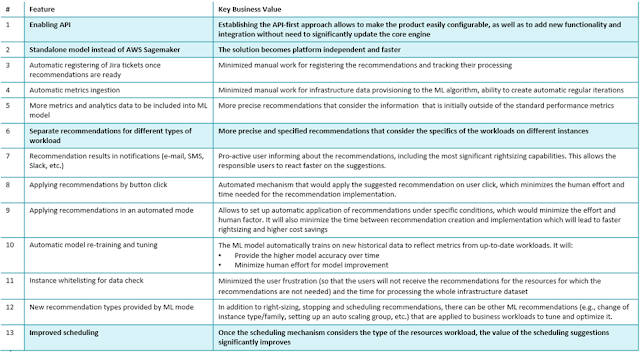Machine-Learning Based Rightsizing: Is it worth it?
Back in March, we shared an exciting story of creating a POC for a machine-learning-based infrastructure rightsizing mechanism.
Naturally,
such an interesting initiative and promising results could not be put aside,
and we went on working on the tool to see how far we could potentially get, and
– of course – if all our work is worth the benefits it could bring.
From POC to a Product
The
initial, POC, version of Maestro Cost Advisor (that’s how we called it) was
actually quite a simple one in terms of the functionality: it took the virtual
machines performance metrics for 4 days, analyzed the CPU and memory load, the
timelines, and suggested the following actions to the instances:
- Scale up
- Scale down
- Shutdown
- Schedule
The mechanism analysed the real load on the instances and
suggested new instance types based on the 90’s percentile for each parameter.
The approach was good enough to prove that the mechanism
would work, but definitely not enough to become a business tool.
Thus, we had a brainstorming session to suggest ideas about
how to turn our POC into an enterprise-ready product. Based on our experience
in working with cloud, as well as on the dialogs with our customers, we
highlighted 13 possible features that could be added within a reasonable time.
And out of them, we highlighted 4 that could be used to create a Minimum Viable
Product (MVP):
Planning a Product
When selecting features for an MVP, we focused on the main
tasks, which definitely needed to be resolved for our mechanism to become a
real value for any business.
·
Enabling API. API-first approach enables quick configuration of the application,
as well as gives the possibility to quickly integrate it with existing own or
third-party systems to bring more value to the customer.
·
Standalone model. Maestro Cost Advisor POC was
built based on AWS Sagemaker, as it was the fastest way for the team to
implement the ML. Even though the tool can potentially work with data from any
cloud (and uses Azure in the POC), having its “brain” in AWS could be a
significant drawback – for both those who just don’t want to use AWS, and those
who want to have all mechanisms within their existing infrastructures.
Thus, we need to rebuild our tool in such a way that it could be deployed on
any customer-defined platform, either Cloud or on-premise.
· Workload-specific recommendations. Any enterprise has multiple environments and workload types. Production and testing, databases and load balancers – each instance has its own tasks and performance specifics. Naturally, the recommendations should take this all into account to bring a real value to the business.
Is it worth it?
Putting effort into creation of a minimum viable product is a
serious decision. It should be balanced carefully considering the effort needed
for implementation and the possible benefits.
We decided to check this by calculating the possible Return
of Investment (ROI), based on a large enterprise infrastructure where we would
be able to try our product, once developed, in action.
Within the calculation, we took into account the time needed
for finalizing the ML-based recommendation mechanism and integrating in with
Maestro (3 months), Maestro licence (based on the covered infrastructure cost),
and the estimated cost of a large-scale enterprise infrastructure.
The result looks more than promising:
Still, at the moment, the mechanism is considered to be a
future part of Maestro, although the implementation is not a top priority task
at the moment.
This means, that once the development is over, the price of
introducing the machine learning to the FinOps processes of Maestro customers
will be even smaller – and the ROI will grow tremendously.






Comments
Post a Comment